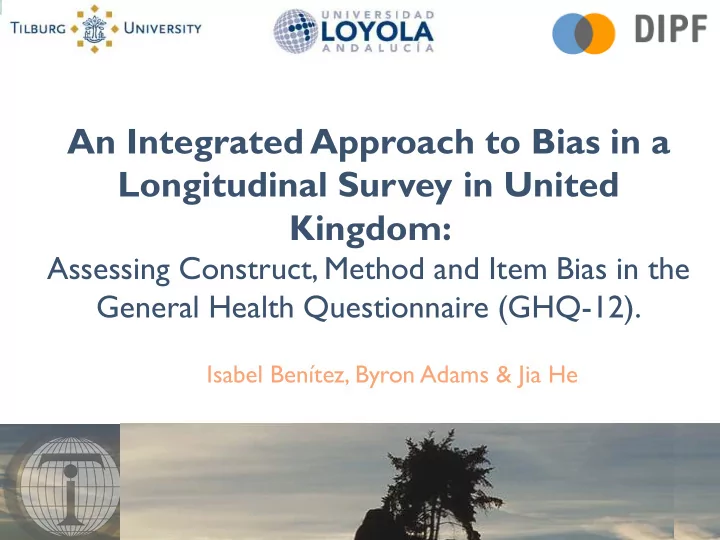

An Integrated Approach to Bias in a Longitudinal Survey in United Kingdom: Assessing Construct, Method and Item Bias in the General Health Questionnaire (GHQ-12). Isabel Benítez, Byron Adams & Jia He
Outline contents Background: Bias in cross-cultural studies Aim of the Project Design of the study Results Conclusions & discussion
Background Cross- A general common aim is to compare cultural studies different cultural and linguistic groups Valid comparisons require evidence of Equivalence the equivalence level reached The equivalence depends on the Bias presence of bias
Bias concept and evaluation BIAS is defined as any nuisance factor in score comparisons (Van de Vijver & Tanzer, 2004) or as the presence of differences in a measurement instrument whose meaning is not exactly the same across cultures (Poortinga, 1989). Three levels Construct Method Item Van de Vijver & Tanzer, (2004)
“Gaps” in the bias interpretation • Analyses are conducted Lack of separately for different integrated results sources of bias • Knowledge about the evolution of bias Lack of results from longitudinal • Identification of systematic elements behind the studies presence of bias
Aim of the study Discover systematic and stable sources of bias in the General Health Questionnaire administered in a longitudinal study
Design of the study • People responding to GHQ-12 across the four waves of Understanding Society • Division: Natives, First Generation & Participants Second Generation of immigrants • GHQ-12: Frequent tool used in the clinical and research context for assessing non psychotic psychiatrics diseases in Instruments communitarian contexts
Design of the study Data cleaning and participants selection Measurement Construct Invariance (MCFA) Analyses of contruct, Extremity method and item bias Method response style across waves (MANOVA) Differential Item Item Functioning Results integration
Results: Contruct bias
Results: Method bias Waves 1-2 First Second Natives Generation Generation BIAS!!!! First Generation Immigrants used extremity significantly more than the other groups
Results: Method bias Waves 3-4 First Second Natives Generation Generation COMPARABLE LEVEL OF EXTREMITY
Results: Item bias Natives-First Generation Global Items W1 W2 W3 W4 Total Total 1 X X 2 4 2 X 1 1 3 0 0 4 X 1 4 5 0 1 6 X X X 3 6 7 0 1 8 0 2 9 0 2 10 X 1 3 11 0 0 12 0 2 T otal 4 2 1 1 8
Integrated results • Items asking about the ability The highest to develop cognitive tasks amount of bias • Item 6 includes the only (Items 1, 4 & 6) negation Item 1. Have you been able to concentrate on what you are doing? Item 4. Did you feel capable of making decisions about things? Item 6. Did you had the feeling you couldn’t overcome your difficulties?
Integrated results The lowest • Items asking self-perceptions amount of bias about personal values (Items 3 & 11) Item 3. Did you feel you are playing a useful part in things? Item 11. Have you been thinking of yourself as a worthless person?
Conclusions Bias Time Related to Negations, Decreases Areas but not type across time assessed of wording
Thank you all for your attention Acknowledgments The research leading to these results has received support under the European Commission’s 7th Framework Programme (FP7/2013-2017) under grant agreement n°312691, InGRID – Inclusive Growth Research Infrastructure Diffusion. Funding This work was supported by a visiting grant from the Integrating expertise in inclusive growth (InGRID). Grants references: c17-13, c17-16 and c17-17.
Recommend
More recommend